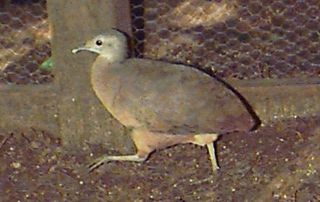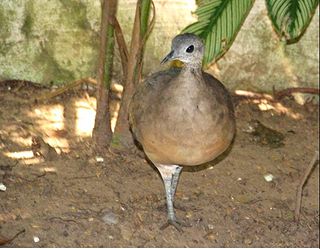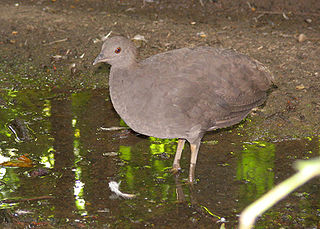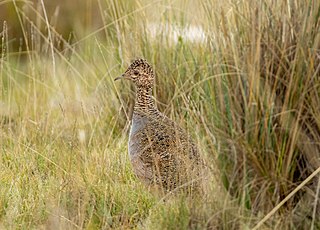Related Research Articles

Tinamous form an order of birds, comprising a single family with two distinct subfamilies, containing 46 species found in Mexico, Central America, and South America. The word "tinamou" comes from the Galibi term for these birds, tinamu. Tinamous have traditionally been regarded as the sister group of the flightless ratites, but recent work places them well within the ratite radiation, implying basal ratites could fly. Tinamous first appear in the fossil record in the Miocene epoch. They are generally sedentary, ground-dwelling and, though not flightless, when possible avoid flight in favour of hiding or running away from danger. They are found in a variety of habitats, ranging from semi-arid alpine grasslands to tropical rainforests. The two subfamilies are broadly divided by habitat, with the Nothurinae referred to as steppe or open country tinamous, and the Tinaminae known as forest tinamous.

The little tinamou is a species of tinamou. It is found in Central and South America.

August von Pelzeln was an Austrian ornithologist. He was a grandson to novelist Karoline Pichler (1769-1843).

The red-winged tinamou is a medium-sized ground-living bird from central and eastern South America. Other common names for the species include perdiz grande, rufous tinamou, and ynambu.

The white-throated tinamou is a species of bird native to the Amazon rainforest of Brazil, northern Bolivia, southeastern Colombia, northeastern Ecuador, eastern Peru and southern Venezuela.

The great tinamou is a species of tinamou ground bird native to Central and South America. There are several subspecies, mostly differentiated by their coloration.

Crypturellus is a genus of tinamous containing mostly forest species. However, there are the odd few that are grassland or steppe tinamous. There are 21 species of and a total of 67 taxa.

The red-legged tinamou or red-footed tinamou, is a ground-dwelling bird found in the tropics and lower subtropics of northern South America.

The solitary tinamou is a species of paleognath ground bird. This species is native to Atlantic forest of eastern Brazil.

The highland tinamou or Bonaparte's tinamou is a type of ground bird found in montane moist forest typically over 1,500 m (4,900 ft) altitude.

The hooded tinamou is a type of ground bird found in forests of Bolivia and Peru.

The cinereous tinamou, also known as brushland tinamou, is a type of ground bird found in swamp and lowland forests in northern South America. They have some localized names that have been used by the indigenous people such as in Amazonas where they are called inambu-pixuna, and in Pará, Brazil where they are called nambu-sujo. Also, throughout their range they are called inhambu-preto. Cinereous tinamous have been around for many centuries. They are part of the oldest families of the world today and have fossils discovered dating back tens of millions of years. Their quick reflexes play a role in their ability to survive.

Bartlett's tinamou is a type of tinamou found in lowland forest in South America.

The Tataupa tinamou is a type of tinamou commonly found in dry forest in subtropical and tropical regions in southeastern South America.

Taczanowski's tinamou is a type of ground bird found in the eastern Andes in Peru in the Junín, Cuzco, Apurímac, Ayacucho, and Puno Regions.

The ornate tinamou is a type of tinamou commonly found in the high altitude grassland and dry shrubland in subtropical and tropical regions of west central South America.

The Chilean tinamou is a type of tinamou commonly found in high altitude shrubland in subtropical regions of central Chile.

The brushland tinamou is a type of Tinamou commonly found in high-altitude dry shrubland in subtropical and tropical regions of southern South America.

Darwin's nothura is a type of tinamou commonly found in high-altitude grassland in the southern Andes in South America.

The Patagonian tinamou also known as Ingouf's tinamou is a member of one of the most ancient groups of paleognath birds, the tinamous. This species is native to southern South America.
References
- ↑ Charles Darwin's egg rediscovered. BBC News. Retrieved 21 September 2013
| | This article about ornithology is a stub. You can help Wikipedia by expanding it. |
| | This history of science article is a stub. You can help Wikipedia by expanding it. |